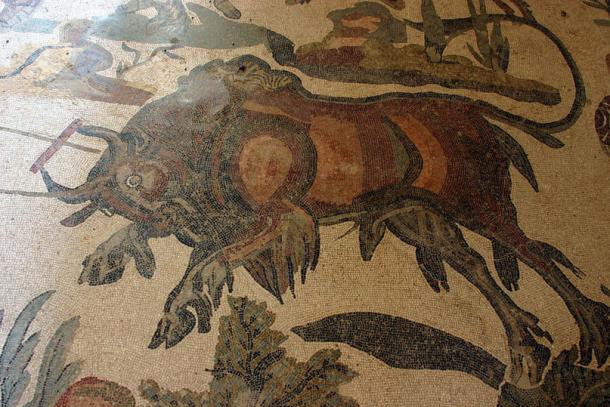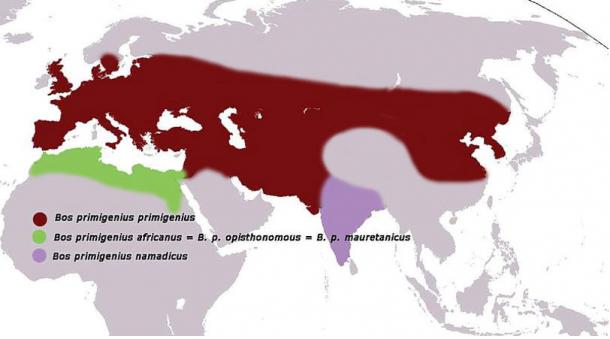Ancients - Scientists Have Almost Completed the Resurrection of Extinct Aurochs and Plan to Reintroduce Them to the Wild
A group of scientists is attempting to re-wild 1 million hectares (2.47 million acres) of European lands, and one of the keys in the circle of life will be reintroducing the fierce, huge, wild aurochs, an ancestor of modern cattle that went extinct centuries ago.
How can they reintroduce an extinct animal?, you may ask. Scientists in the Netherlands, Belgium, Czech Republic, Romania and Croatia are back-breeding specimens of the animal from modern cattle that retain the most genes of the extinct beast. So far scientists in those countries have bred about 500 animals.
Aurochs are ancestors of modern cattle but stood taller at 7 feet (2.13 meters) at the shoulder as compared to 5 feet of modern cattle. They weighed about 2,200 pounds (998 pounds).

This mosaic from an Italian villa shows a hunt of the ancient aurochs. (Wikimedia Commons/José Luiz Bernardes Ribeiro photo)
As Natalia Klimczak of Ancient Origins reported earlier in 2016, the Dutch nonprofit group named Stichting Taurus is providing financial support to the TaurOs Project , which is a partnership of ecologists, geneticists, historians, and cattle breeders. They are seeking to re-create the aurochs by crossbreeding modern cattle in the back breeding process. They say that laboratory-based genetic engineering is not required for the task. The process they've chosen instead is the selective breeding of animals that exist today to get as close as possible to their now-extinct ancestors.
Scientists have been working on the project since 2009 and have come closer to a genuine auroch with each generation, reports The Telegraph.
Italian scientist Donato Matassino of Operation Tauros told the newspaper: “I don’t think we’ll ever be able to create an animal that is 100 per cent like the aurochs, but we can get very close.” Dr. Matassino is with the Italian government’s Consortium for Experimentation and Application of Biotechnical Innovates.
Operation Tauros has produced about 300 calves at sites in the Netherlands and Hungary, and other laboratories are producing more of the animals. Scientists say with every generation, the animals more closely resemble and act like aurochs.
Scientists are breeding the most primitive European cattle with the most characteristics of the extinct aurochs, including the Maremmana and Podolica cattle of Italy and the Busha of the Balkans.
These life scientists were helped by the find of a 6,700-year-old humerus bone of an aurochs in a cave in Derbyshire, England. They sequenced the genome of the aurochs from that bone in 2014 and now have a way to compare genes of modern cattle to extinct specimens.
The range of the aurochs was not just in Europe but also in Asia and North Africa. The majestic beast was gone from Britain during the Iron Age and from the rest of Europe by 1627. The last specimen of the Bos primigenius primigenius died that year in a Polish forest.

The habitat of Bos primigenius primegenius or aurochs is shown in red. The last living specimen was believed to have died in a Polish forest in 1627. (Wikimedia Commons/Christophe cage map)
Dr. Matassino told the Telegraph if aurochs can be resurrected and let loose in the wild, they could play an important part in forest ecology by keeping meadows and grasslands clear by eating bushes and trampling vegetation.
Rewilding Europe is a conservation group established in 2011 to restore lands from Portugal to the Danube Delta to a natural state by 2022. The group wants to reintroduce wild hoses, the European bison or wisent and the ibex as well as the aurochs.
“If there are no large herbivores, then the forest regenerates very fast,” Rewilding Europe’s Wouter Helmer told the Telegraph. “Big grazing animals keep patches of land open and create variety in the landscape which helps many thousands of species of plants, insects and animals.”
Aurochs are important not just for their ability to keep wild lands healthy but also in European culture. Cave paintings dating to thousands of years ago show aurochs.
Rewilding Europe has some clout. It receives money from the European Commission, the World Wildlife Fund, the Dutch lottery and other partners.

No comments:
Post a Comment